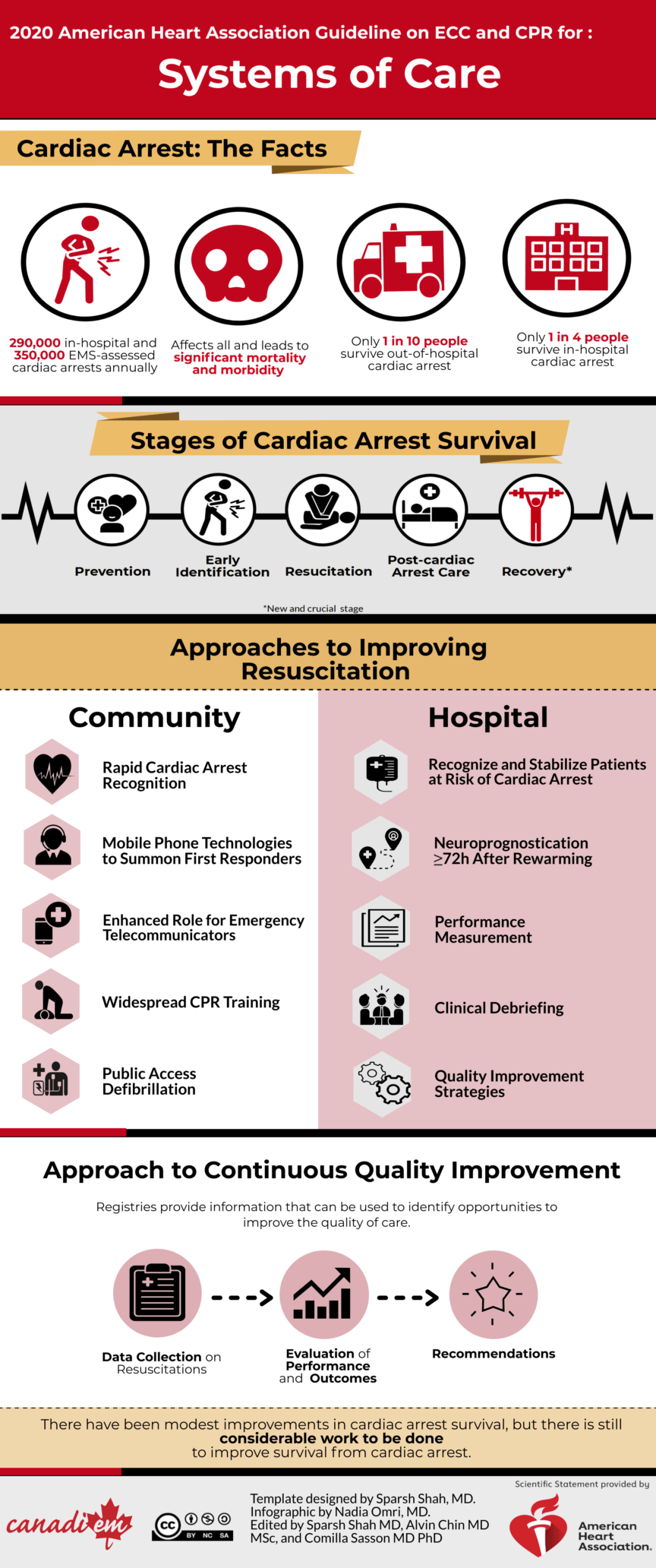This year, the American Heart Association (AHA) released the updated 2020 Guidelines for Cardiopulmonary Resuscitation and Emergency Cardiovascular Care; the first major update to the internationally recognized guideline in five years. CanadiEM and the AHA came together to create an infographic which summarizes the new updates pertaining to the Systems of Care.
Here are the top 10 things you should know!
- Over 350,000 EMS-assessed cardiac arrests and 209,000 in-hospital cardiac arrests occur annually in the US. Despite advances in resuscitation science, survival rates for out of hospital cardiac arrest are only at best about 10%. Survival from in-hospital cardiac arrest is about 25%.
- The 2020 Guidelines is based on the extensive evidence evaluation performed in conjunction with the International Liaison Committee on Resuscitation and affiliated International Liaison Committee on Resuscitation member councils. Three different types of evidence reviews (systematic reviews, scoping reviews, and evidence updates) were used in the 2020 process. Each of these resulted in a description of the literature that facilitated guideline development.
- Previous systems of care guidelines have identified a chain of survival, beginning with prevention and early identification of cardiac arrest and proceeding through resuscitation to post–cardiac arrest care. This concept is reinforced by the addition of recovery as an important stage in cardiac arrest survival.
- Debriefing and other quality improvement strategies were previously mentioned and are now emphasized.
- Specific to out-of-hospital cardiac arrest, this Part contains recommendations about community initiatives to promote cardiac arrest recognition, cardiopulmonary resuscitation, public access defibrillation, mobile phone technologies to summon first responders, and an enhanced role for emergency telecommunicators.
- Germane to IHCA are recommendations about the recognition and stabilization of hospital patients at risk for developing cardiac arrest.
- This part also includes recommendations about clinical debriefing, transport to specialized cardiac arrest centers, organ donation, and performance measurement across the continuum of resuscitation situations.
- Cognitive aids (prompts designed to help individuals and teams to recall information, complete tasks, and adhere to guideline recommendations) may improve resuscitation performance by untrained laypersons, but their use results in a delay to starting CPR. More development and study are needed before these systems can be fully endorsed.
- Continuous improvement starts with disciplined collection and evaluation of data on resuscitation performance and outcomes and the Systems of Care chapter addresses this approach. Registries provide information that can be used to identify opportunities to improve the quality of care.
- Cardiac arrest remains a condition with considerable morbidity and mortality that broadly affects individuals across age, gender, race, geography, and socioeconomic status. Although there have been modest improvements in survival, there is still considerable work to be done to address the significant burden of this disease.


Further reading:
Heart & Stroke 2020 Guidelines for CPR and Emergency Cardiovascular Care
American Heart Association 2020 Guidelines for CPR and Emergency Cardiovascular Care





